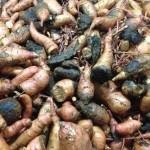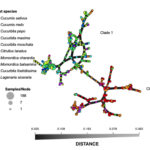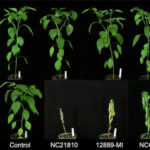 | Epidemiology of post harvest diseases
North Carolina is the largest producer of sweetpotato in the U.S. Every year growers and packers suffer losses due to post harvest diseases. We are studying epidemiological factors that favor diseases caused by pathogens infecting sweetpotatoes post harvest such as Rhizopus stolonifer, Fusarium sp., and Ceratocystis fimbriata. Our goal is to improve control measures to increase the quality of sweepotatoes in storage for seed production, domestic consumption, and export markets. |
 | Fungicide resistance
Growers rely on fungicides to control pathogens of cucurbit crops and sweetpotato. Unfortunately, pathogen populations can develop fungicide resistance over time forcing companies and growers to seek alternatives for effective control. We are combining genetic and field approaches to determine what products are effective for control of vegetable pathogens, how fungicide resistance develops in pathogen populations, and how we can modify spray programs to increase the long term efficacy of fungicides. Some pathogens we study for fungicide resistance include Fusarium oxysporum, Ceratocystis fimbriata, Pseudoperonospora cubensis, and Phytophthora capsici. |
 | Biosurveillance of plant pathogens
Advances in Next Generation Sequencing (NGS) allow for rapid development of genomics resources needed to generate markers for diagnostics, population analyses, and tracking virulence shifts of plant pathogens. Accurate diagnosis is the first step to disease control and understanding the population dynamics of plant pathogens can inform management strategies. NGS approaches are particularly helpful for organisms that cannot be cultured, such as the downy mildew pathogens. We have developed genomics, diagnostics, and biosurveillance resources for Pseudoperonospora cubensis (cucurbit downy mildew), Pseudoperonospora humuli (hop downy mildew), Peronospora belbahrii (basil downy mildew), and Ceratocystis fimbriata. |
 | Host resistance to vegetable pathogens
Host resistance is a preferred method for disease control; however, breeding for resistance is a long term process and pathogens can overcome resistant varieties. We evaluate commercial, wild, and breeding lines for resistance to plant pathogens causing losses to vegetable growers in North Carolina to accelerate the breeding process. We are also using comparative genomics to identify key effectors to target for effector-assisted breeding. Some of the pathogens we are using to identify host resistance are Pseudoperonospora cubensis in cucurbits, Phytophthora capsici in solanaceous and cucurbit crops, and Ceratocystis fimbriata in sweetpotato. |